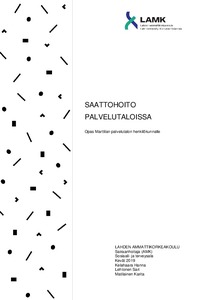Saattohoito palvelutaloissa : Opas Marttilan palvelutalon henkilökunnalle
Lehtonen, Sari; Kelahaara, Hanna; Matilainen, Karita (2019)
Lehtonen, Sari
Kelahaara, Hanna
Matilainen, Karita
2019
Kaikki oikeudet pidätetään
Julkaisun pysyvä osoite on
https://urn.fi/URN:NBN:fi:amk-201903153184
https://urn.fi/URN:NBN:fi:amk-201903153184
Tiivistelmä
Tämän opinnäytetyön tarkoituksena oli tarjota tietoa laadukkaan saattohoidon toteuttamiseksi palvelutaloissa. Tavoitteena oli laatia saattohoito-opas henkilökunnan käyttöön. Opinnäytetyö tehtiin Orimattilassa sijaitsevan Marttilan palvelutalon tilauksesta, mutta työtä on mahdollista hyödyntää myös muissa palvelutaloissa. Työ on suunnattu palvelutalojen saattohoidon tueksi, minkä vuoksi työssä käytetään asukas-sanaa potilaan sijaan.
Opinnäytetyö on toteutettu toiminnallisena työnä, jonka teoriatieto on kerätty alan kirjallisuudesta, Käypähoitosuosituksista, tutkimuksista, kansainvälisistä lähteistä sekä saattohoitosuosituksista. Teoriaosuudessa käsitellään saattohoitoa asukas kokonaisvaltaisesti huomioiden.
Saattohoito koostuu monista eri asioista. Tärkeintä on asukkaan kivun lievitys ja oireiden hoito, asukkaan toiveiden kunnioittaminen sekä omaisten tukeminen. Tärkeää on myös kouluttaa ja tukea henkilökuntaa, millä mahdollistetaan laadukkaan saattohoidon toteutuminen.
Opas on mahdollisimman selkeä ja helppolukuinen, myös visuaalisuus on huomioitu. Opas perustuu tutkittuun sekä näyttöön perustuvaan tietoon, ja sen kokoamisessa on otettu huomioon Marttilan palvelutalon henkilökunnan toiveet.
The aim of our thesis is to offer information on how to carry out high-quality end-of-life care in nursing homes. Our immediate goal was to compile a guidebook for the staff of Marttila nursing home in Orimattila, who commissioned the study. Our work can be utilized in other nursing facilities as well. The intended audience of the thesis is the nursing home staff, who provide terminal care to residents in nursing homes, therefore we refrain from using the word patient.
The study was carried out as an action research. The theoretical framework has been compiled from scientific literature, Current Care Guidelines, research and studies, international sources and guidelines for end-of-life care. The theoretical section of the thesis offers a holistic view of the residents of nursing homes.
End-of-life care consists of various factors. Among the most important ones are pain relief, treatment of symptoms, respecting the resident’s wishes concerning their care, and supporting the residents’ family members. It is also important to train and support the staff to ensure high-quality care.
The guide has been made simple and easy to read. The text is complimented with visual aids. The guidelines we lay out are based on scientifically conducted evidence-based research. The wishes of the staff of Marttila nursing home have also been taken into consideration.
Opinnäytetyö on toteutettu toiminnallisena työnä, jonka teoriatieto on kerätty alan kirjallisuudesta, Käypähoitosuosituksista, tutkimuksista, kansainvälisistä lähteistä sekä saattohoitosuosituksista. Teoriaosuudessa käsitellään saattohoitoa asukas kokonaisvaltaisesti huomioiden.
Saattohoito koostuu monista eri asioista. Tärkeintä on asukkaan kivun lievitys ja oireiden hoito, asukkaan toiveiden kunnioittaminen sekä omaisten tukeminen. Tärkeää on myös kouluttaa ja tukea henkilökuntaa, millä mahdollistetaan laadukkaan saattohoidon toteutuminen.
Opas on mahdollisimman selkeä ja helppolukuinen, myös visuaalisuus on huomioitu. Opas perustuu tutkittuun sekä näyttöön perustuvaan tietoon, ja sen kokoamisessa on otettu huomioon Marttilan palvelutalon henkilökunnan toiveet.
The aim of our thesis is to offer information on how to carry out high-quality end-of-life care in nursing homes. Our immediate goal was to compile a guidebook for the staff of Marttila nursing home in Orimattila, who commissioned the study. Our work can be utilized in other nursing facilities as well. The intended audience of the thesis is the nursing home staff, who provide terminal care to residents in nursing homes, therefore we refrain from using the word patient.
The study was carried out as an action research. The theoretical framework has been compiled from scientific literature, Current Care Guidelines, research and studies, international sources and guidelines for end-of-life care. The theoretical section of the thesis offers a holistic view of the residents of nursing homes.
End-of-life care consists of various factors. Among the most important ones are pain relief, treatment of symptoms, respecting the resident’s wishes concerning their care, and supporting the residents’ family members. It is also important to train and support the staff to ensure high-quality care.
The guide has been made simple and easy to read. The text is complimented with visual aids. The guidelines we lay out are based on scientifically conducted evidence-based research. The wishes of the staff of Marttila nursing home have also been taken into consideration.
